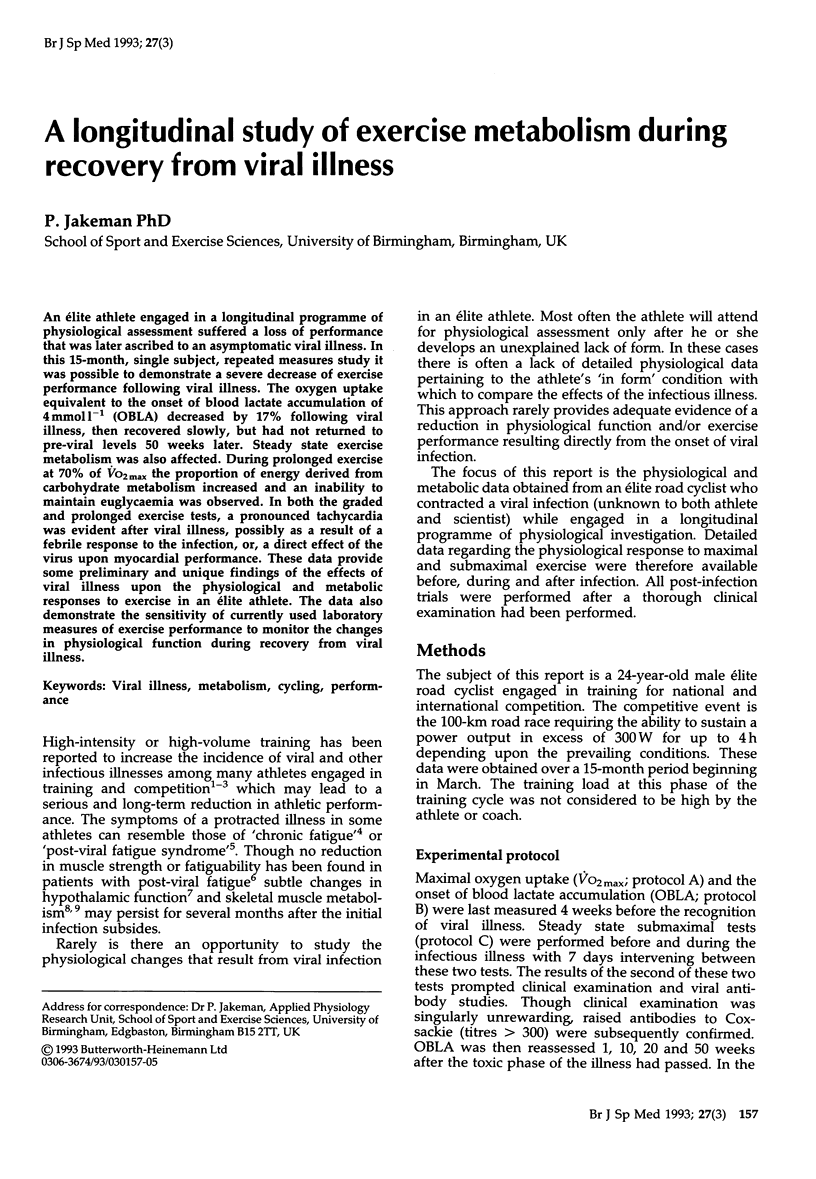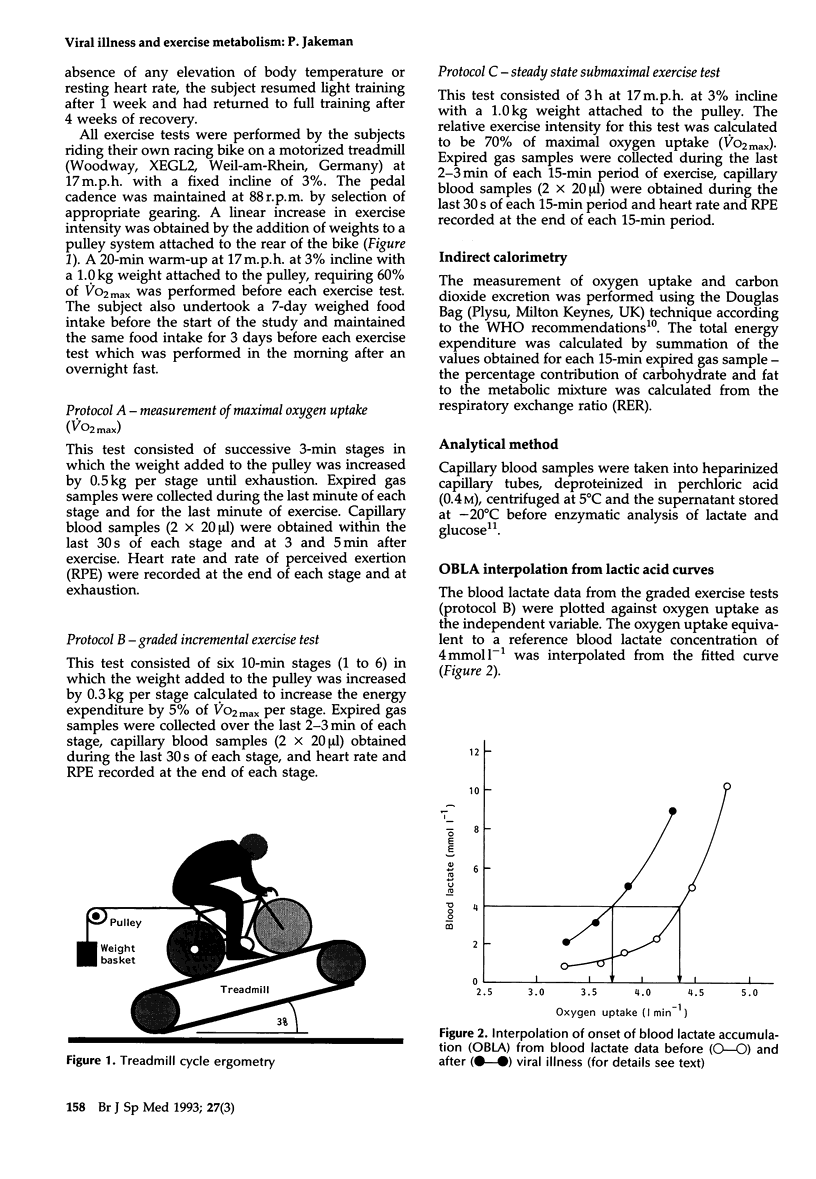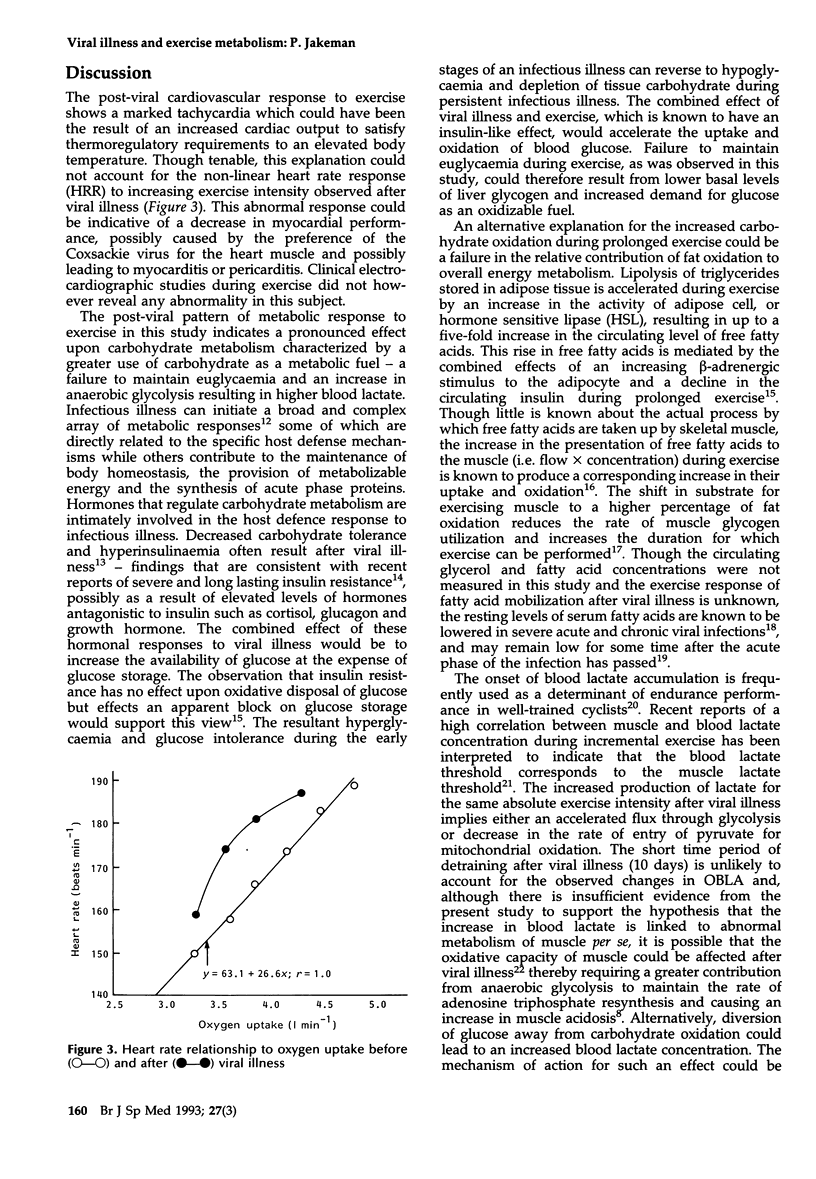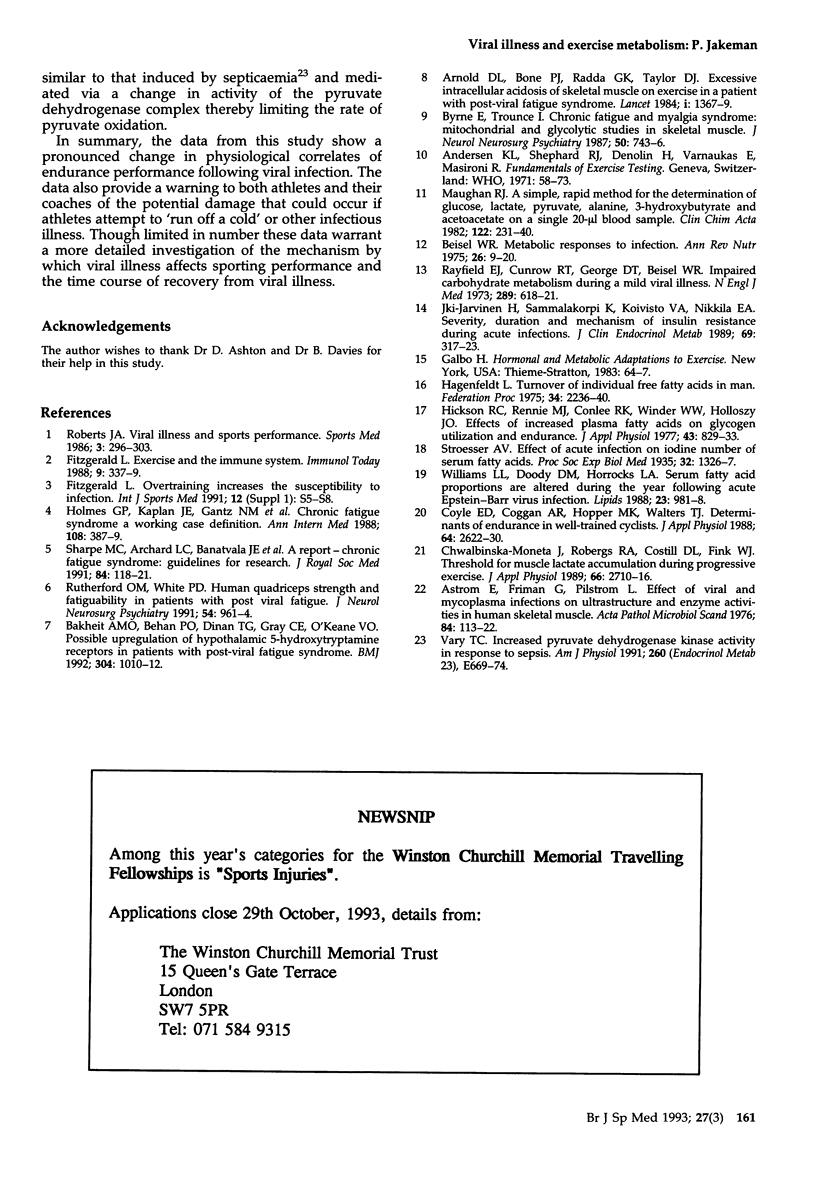Abstract
An élite athlete engaged in a longitudinal programme of physiological assessment suffered a loss of performance that was later ascribed to an asymptomatic viral illness. In this 15-month, single subject, repeated measures study it was possible to demonstrate a severe decrease of exercise performance following viral illness. The oxygen uptake equivalent to the onset of blood lactate accumulation of 4 mmol l-1 (OBLA) decreased by 17% following viral illness, then recovered slowly, but had not returned to pre-viral levels 50 weeks later. Steady state exercise metabolism was also affected. During prolonged exercise at 70% of VO2max the proportion of energy derived from carbohydrate metabolism increased and an inability to maintain euglycaemia was observed. In both the graded and prolonged exercise tests, a pronounced tachycardia was evident after viral illness, possibly as a result of a febrile response to the infection, or, a direct effect of the virus upon myocardial performance. These data provide some preliminary and unique findings of the effects of viral illness upon the physiological and metabolic responses to exercise in an élite athlete. The data also demonstrate the sensitivity of currently used laboratory measures of exercise performance to monitor the changes in physiological function during recovery from viral illness.
Full text
PDF




Selected References
These references are in PubMed. This may not be the complete list of references from this article.
- Arnold D. L., Bore P. J., Radda G. K., Styles P., Taylor D. J. Excessive intracellular acidosis of skeletal muscle on exercise in a patient with a post-viral exhaustion/fatigue syndrome. A 31P nuclear magnetic resonance study. Lancet. 1984 Jun 23;1(8391):1367–1369. doi: 10.1016/s0140-6736(84)91871-3. [DOI] [PubMed] [Google Scholar]
- Aström E., Friman G., Pilström L. Effects of viral and mycoplasma infections on ultrastructure and enzyme activities in human skeletal muscle. Acta Pathol Microbiol Scand A. 1976 Mar;84(2):113–122. doi: 10.1111/j.1699-0463.1976.tb00080.x. [DOI] [PubMed] [Google Scholar]
- Bakheit A. M., Behan P. O., Dinan T. G., Gray C. E., O'Keane V. Possible upregulation of hypothalamic 5-hydroxytryptamine receptors in patients with postviral fatigue syndrome. BMJ. 1992 Apr 18;304(6833):1010–1012. doi: 10.1136/bmj.304.6833.1010. [DOI] [PMC free article] [PubMed] [Google Scholar]
- Beisel W. R. Metabolic response to infection. Annu Rev Med. 1975;26:9–20. doi: 10.1146/annurev.me.26.020175.000301. [DOI] [PubMed] [Google Scholar]
- Byrne E., Trounce I. Chronic fatigue and myalgia syndrome: mitochondrial and glycolytic studies in skeletal muscle. J Neurol Neurosurg Psychiatry. 1987 Jun;50(6):743–746. doi: 10.1136/jnnp.50.6.743. [DOI] [PMC free article] [PubMed] [Google Scholar]
- Chwalbinska-Moneta J., Robergs R. A., Costill D. L., Fink W. J. Threshold for muscle lactate accumulation during progressive exercise. J Appl Physiol (1985) 1989 Jun;66(6):2710–2716. doi: 10.1152/jappl.1989.66.6.2710. [DOI] [PubMed] [Google Scholar]
- Coyle E. F., Coggan A. R., Hopper M. K., Walters T. J. Determinants of endurance in well-trained cyclists. J Appl Physiol (1985) 1988 Jun;64(6):2622–2630. doi: 10.1152/jappl.1988.64.6.2622. [DOI] [PubMed] [Google Scholar]
- Fitzgerald L. Exercise and the immune system. Immunol Today. 1988 Nov;9(11):337–339. doi: 10.1016/0167-5699(88)91332-1. [DOI] [PubMed] [Google Scholar]
- Fitzgerald L. Overtraining increases the susceptibility to infection. Int J Sports Med. 1991 Jun;12 (Suppl 1):S5–S8. doi: 10.1055/s-2007-1024742. [DOI] [PubMed] [Google Scholar]
- Hickson R. C., Rennie M. J., Conlee R. K., Winder W. W., Holloszy J. O. Effects of increased plasma fatty acids on glycogen utilization and endurance. J Appl Physiol Respir Environ Exerc Physiol. 1977 Nov;43(5):829–833. doi: 10.1152/jappl.1977.43.5.829. [DOI] [PubMed] [Google Scholar]
- Holmes G. P., Kaplan J. E., Gantz N. M., Komaroff A. L., Schonberger L. B., Straus S. E., Jones J. F., Dubois R. E., Cunningham-Rundles C., Pahwa S. Chronic fatigue syndrome: a working case definition. Ann Intern Med. 1988 Mar;108(3):387–389. doi: 10.7326/0003-4819-108-3-387. [DOI] [PubMed] [Google Scholar]
- Maughan R. J. A simple, rapid method for the determination of glucose, lactate, pyruvate, alanine, 3-hydroxybutyrate and acetoacetate on a single 20-mul blood sample. Clin Chim Acta. 1982 Jul 1;122(2):231–240. doi: 10.1016/0009-8981(82)90282-0. [DOI] [PubMed] [Google Scholar]
- Rayfield E. J., Curnow R. T., George D. T., Beisel W. R. Impaired carbohydrate metabolism during a mild viral illness. N Engl J Med. 1973 Sep 20;289(12):618–621. doi: 10.1056/NEJM197309202891207. [DOI] [PubMed] [Google Scholar]
- Roberts J. A. Viral illnesses and sports performance. Sports Med. 1986 Jul-Aug;3(4):298–303. doi: 10.2165/00007256-198603040-00006. [DOI] [PMC free article] [PubMed] [Google Scholar]
- Rutherford O. M., White P. D. Human quadriceps strength and fatiguability in patients with post viral fatigue. J Neurol Neurosurg Psychiatry. 1991 Nov;54(11):961–964. doi: 10.1136/jnnp.54.11.961. [DOI] [PMC free article] [PubMed] [Google Scholar]
- Sharpe M. C., Archard L. C., Banatvala J. E., Borysiewicz L. K., Clare A. W., David A., Edwards R. H., Hawton K. E., Lambert H. P., Lane R. J. A report--chronic fatigue syndrome: guidelines for research. J R Soc Med. 1991 Feb;84(2):118–121. doi: 10.1177/014107689108400224. [DOI] [PMC free article] [PubMed] [Google Scholar]
- Vary T. C. Increased pyruvate dehydrogenase kinase activity in response to sepsis. Am J Physiol. 1991 May;260(5 Pt 1):E669–E674. doi: 10.1152/ajpendo.1991.260.5.E669. [DOI] [PubMed] [Google Scholar]
- Williams L. L., Doody D. M., Horrocks L. A. Serum fatty acid proportions are altered during the year following acute Epstein-Barr virus infection. Lipids. 1988 Oct;23(10):981–988. doi: 10.1007/BF02536347. [DOI] [PubMed] [Google Scholar]
- Yki-Järvinen H., Sammalkorpi K., Koivisto V. A., Nikkilä E. A. Severity, duration, and mechanisms of insulin resistance during acute infections. J Clin Endocrinol Metab. 1989 Aug;69(2):317–323. doi: 10.1210/jcem-69-2-317. [DOI] [PubMed] [Google Scholar]


